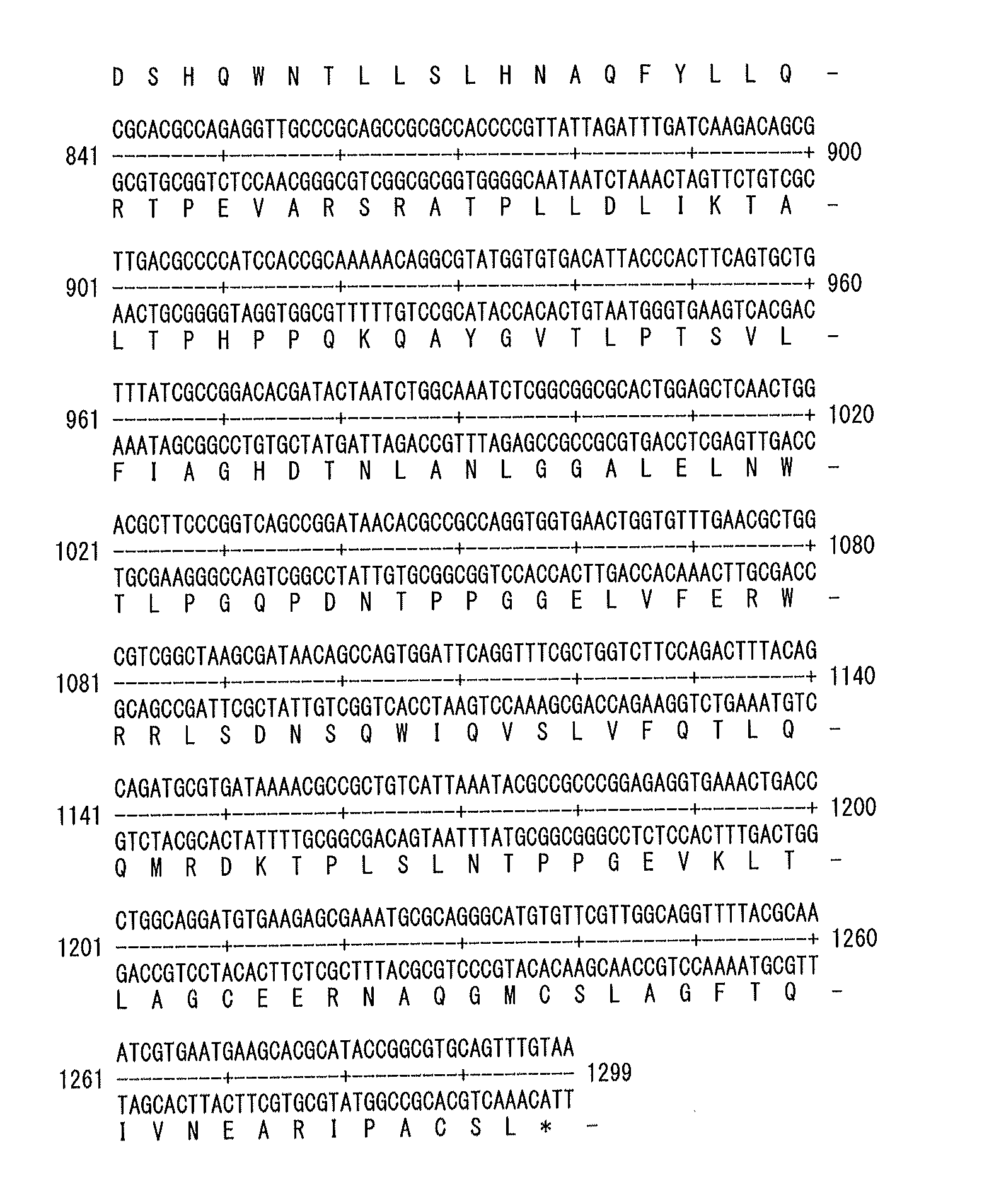Thermotolerant non-k12 escherichia coli phytase and its production
a technology of escherichia coli and phytase, which is applied in the field of thermotolerant non-k12 escherichia coli phytase and its production, can solve the problems of poor digestibility of phosphorus in this form, many of the currently used phytases losing activity during feed pelleting process, and many of the currently used phytases not being adequate in instability
- Summary
- Abstract
- Description
- Claims
- Application Information
AI Technical Summary
Benefits of technology
Problems solved by technology
Method used
Image
Examples
example 1
Cloning of Non-K12 Escherichia coli Phytase
[0089]Escherichia coli (ATCC 9637, purchased from ATCC) was grown in a LB medium (LB Nutrient, Beijing Luqiao Technology Co. Ltd.) at 37° C. with shaking overnight. Genomic DNA was prepared using a Puregene DNA Isolation Kit according to the manufacturer's specification (Gentra Systems, Minneapolis, Minn.). PCR primers (OLIGO ID NOs.: 1˜6, FIG. 3) were designed and synthesized (Invitrogen Biotechnology Co., Ltd) for cloning the genomic sequence of non-K12 Escherichia coli phytase. A PCR reaction was run using InsT / Aclone™ PCR Product Cloning Kit (Fermentas Life Sciences) to obtain the genomic sequence. PCR reaction mixture: 0.1 mM dNTP, 0.05 mM Primer, 10 ng genomic template DNA, 2 units Taq DNA polymerase, 5 mM MgCl2, 10 mM Tris-HCl buffer pH 7.5 to a total liquid volume of 0.1 ml. The above reaction (0.1 ml) was mixed in a reaction tube (0.2 ml) and set in the DNA Thermal Cycler (Perkin-Elmer Thermocycler Type 2400) to be subjected to
[009...
example 2
Expression of Non-K12 Escherichia coli phytase (W-PhE) in Escherichia coli
[0093]The E. coli transformant obtained in Example 1 was cultured with shaking for 20 hours at 37° C. in a culture medium (1% tryptone, 0.5% yeast extract, 1% sodium chloride, 50 μg / ml ampicillin). The overnight culture was added, at a ratio of 1 / 100 volume, into a fresh medium the same as the above, and was incubated under the same condition. When the culture reached OD550 0.5, 1 M IPTG was added to a final concentration of 1 mM. The incubation was continued for another 20 hours to induce the phytase gene expression. The cells were harvested by centrifugation, washed twice with distilled water, and then suspended at 100 mg wet cells / ml in HAC-Na buffer (0.1 M, pH 5.8). The harvested cells were then disrupted using an ultrasonic disintegrator (COSMO BIO CO., LTD). The supernatant was separated from the debris and subjected to SDS-polyacrylamide gel electrophoresis. The expressed protein was confirmed by the e...
example 3
Production of Non-K12 Escherichia coli Phytase (W-PhE) Via Fermentation of Escherichia coli
[0095]The production of non-K12 E. coli phytase in a 14 L Braun Biostat C fermentor (B. Braun Biotech International Gmbh, Melsungen, Germany) used the mineral medium containing glucose, ammonia, and yeast extract (OXOID LTD., BASINFSTOKE HAMPSHIRE , ENGLAND).
[0096]E. coli strain pTrcHis2-PhE / MG1655 harboring plasmid pTrcHis2-PhE prepared in Example 1 was grown in a LB medium to prepare the seed culture for inoculation. The 500 mL seed culture was grown in a 2 L flask at 37° C., 300 rpm until OD (λ.=550)>2.0. This may take about 10 hrs.
[0097]The vessel medium was prepared in an initial batch volume of 7.5 L, which contained 32 g KH2PO4, 8.0 g MgSO4.7H2O, 8.0 g (NH4)2SO4, 50 g yeast extract, and 10 mL Mazu DF204 antifoam (BASF Corporation, Mount Olive, N.J.) in distilled water. The fermentor filled with the medium was then steam sterilized. Following sterilization, 369 g glucose aqueous solutio...
PUM
| Property | Measurement | Unit |
|---|---|---|
| Fraction | aaaaa | aaaaa |
Abstract
Description
Claims
Application Information
 Login to View More
Login to View More - R&D
- Intellectual Property
- Life Sciences
- Materials
- Tech Scout
- Unparalleled Data Quality
- Higher Quality Content
- 60% Fewer Hallucinations
Browse by: Latest US Patents, China's latest patents, Technical Efficacy Thesaurus, Application Domain, Technology Topic, Popular Technical Reports.
© 2025 PatSnap. All rights reserved.Legal|Privacy policy|Modern Slavery Act Transparency Statement|Sitemap|About US| Contact US: help@patsnap.com



